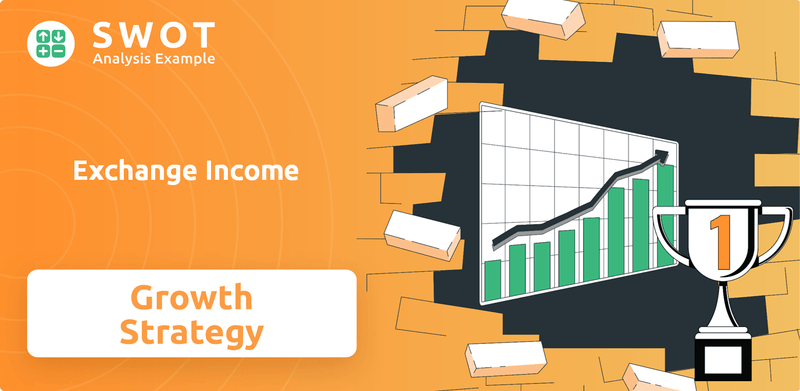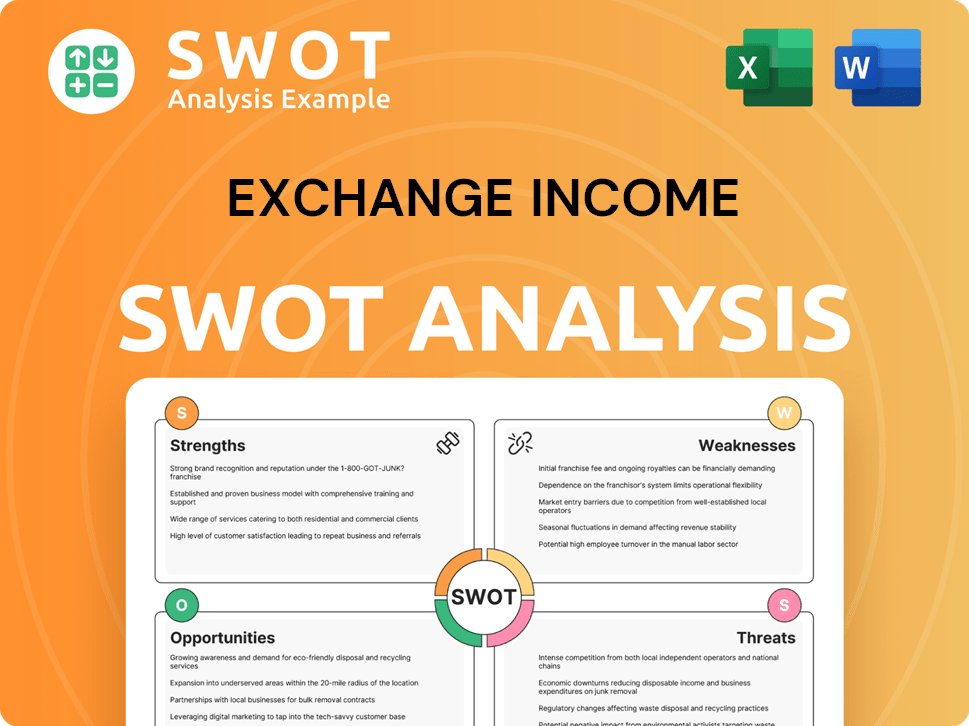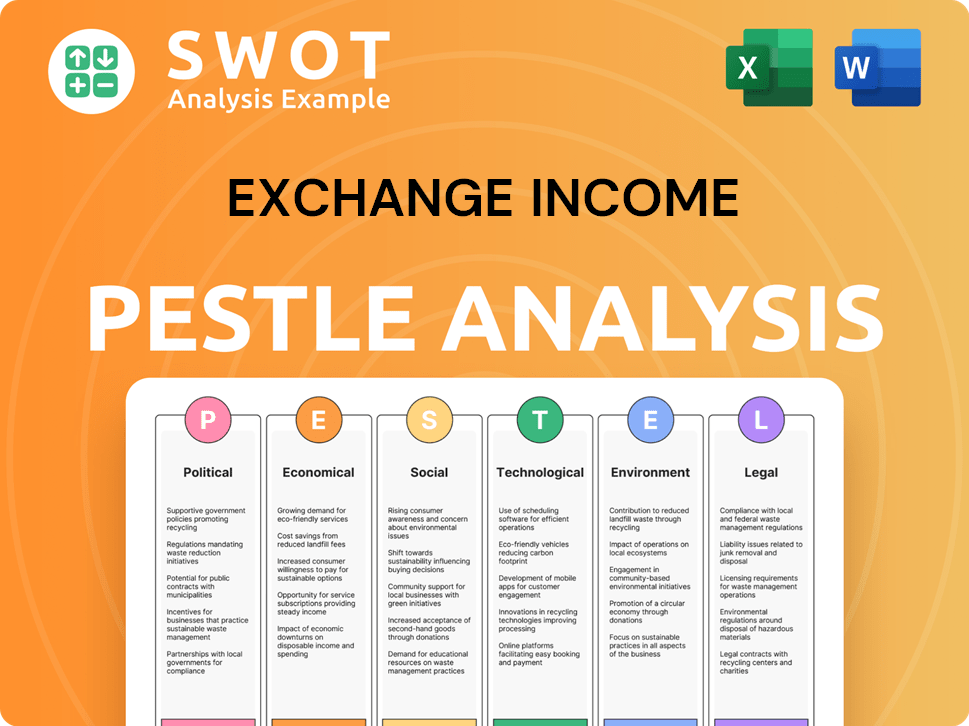Exchange Income Bundle
Can Exchange Income Company Maintain Its Growth Trajectory?
Exchange Income Company, a prominent player in aerospace, aviation, and manufacturing, has built its success on a foundation of strategic acquisitions. Founded in 2004, the company has evolved into a diversified entity with a significant North American footprint. This article will explore the Exchange Income SWOT Analysis and delve into the Growth Strategy and Future Prospects of this dynamic company.

EIC's unique approach, empowering acquired businesses while providing centralized support, has been a key differentiator, driving consistent Financial Performance and expansion. We will examine its strategic initiatives, including expansion plans, innovation, and its financial outlook. A thorough Market Analysis will be conducted, considering both the opportunities and potential risks that could shape its future, providing valuable insights for investors and stakeholders alike. The Exchange Income Company presents a compelling case study for understanding successful growth strategies.
How Is Exchange Income Expanding Its Reach?
The Exchange Income Company's (EIC) growth strategy is primarily driven by acquisitions, focusing on profitable, well-established businesses within the aerospace, aviation, and manufacturing sectors. This approach allows EIC to rapidly expand its market share and diversify its revenue streams. The company's expansion initiatives are designed to enhance its geographical reach, diversify its product and service offerings, and strengthen its existing capabilities.
EIC's expansion strategy involves both inorganic and organic growth. Inorganic growth is achieved through strategic acquisitions, while organic growth is fostered within the acquired businesses through capital investments in facility upgrades, equipment, and talent. This dual approach enables EIC to achieve rapid expansion while simultaneously strengthening its operational capabilities.
A recent example of EIC's expansion strategy is the acquisition of Ben Machine Products in February 2024. This acquisition added specialized machining capabilities and a strong customer base to EIC's manufacturing segment. The company has shown interest in expanding its presence in the U.S. market, particularly within its aerospace and aviation segments, to capitalize on larger market opportunities and diversify its revenue streams further.
EIC targets companies in the aerospace, aviation, and manufacturing sectors. These sectors provide stable, predictable cash flows, which are essential for EIC's business model. The company looks for businesses with strong management teams and established market positions.
EIC aims to expand its presence in the U.S. market. This expansion is expected to diversify revenue streams and provide access to larger market opportunities. The company's focus on the U.S. market is a key part of its long-term growth strategy.
EIC supports its acquired businesses with capital for facility upgrades, equipment purchases, and talent acquisition. This investment in existing operations is a critical component of EIC's growth strategy. The company aims to improve operational efficiency and increase profitability within its existing portfolio.
EIC's growth strategy is supported by thorough market analysis. The company carefully evaluates potential acquisition targets and assesses market trends to make informed investment decisions. This data-driven approach is crucial for sustainable growth.
EIC's future prospects are positive, with continued growth expected through strategic acquisitions and organic initiatives. The company's focus on the aerospace, aviation, and manufacturing sectors provides a solid foundation for long-term success. EIC's dividend yield analysis and financial performance are key indicators of the company's investment potential.
- Continued acquisitions in core sectors.
- Expansion in the U.S. market.
- Investment in organic growth within existing businesses.
- Focus on sustainable growth initiatives.
Exchange Income SWOT Analysis
- Complete SWOT Breakdown
- Fully Customizable
- Editable in Excel & Word
- Professional Formatting
- Investor-Ready Format

How Does Exchange Income Invest in Innovation?
The innovation and technology strategy of Exchange Income Company (EIC) is primarily driven through its diverse portfolio of operating companies. As an acquisition-oriented holding company, EIC supports its subsidiaries in their individual innovation efforts and technological advancements. This approach allows for a decentralized yet coordinated strategy, leveraging the specific expertise and market knowledge of each subsidiary.
EIC's strategy involves encouraging its subsidiaries to adopt cutting-edge technologies that can provide a competitive advantage. This includes initiatives like advanced manufacturing processes, digital transformation in the manufacturing segment, and the adoption of new technologies in its aerospace and aviation businesses. The focus is on fostering a culture of continuous improvement and technological adoption across its operating companies.
While EIC does not typically engage in centralized research and development, it facilitates knowledge sharing and best practices among its subsidiaries. This collaborative environment ensures that the benefits of technological advancements are spread throughout the organization. The company's strategic guidance often encourages its operating companies to explore innovations that can enhance operational efficiencies and service offerings.
Subsidiaries in the aerospace sector may invest in upgrading fleets with more fuel-efficient aircraft. This contributes to operational efficiencies and enhanced service offerings. These investments are crucial for maintaining competitiveness and adapting to evolving industry standards.
EIC-backed companies are increasingly exploring automation and advanced robotics. This is done to improve production efficiency and precision. Such technological adoption helps in streamlining operations and reducing costs.
EIC facilitates knowledge sharing among its subsidiaries to foster a culture of continuous improvement. This collaborative approach ensures that best practices are widely adopted. This helps in driving innovation and operational excellence across the entire organization.
The company's strategic guidance encourages operating companies to explore cutting-edge technologies. This can provide a competitive advantage through new product development or process optimization. This proactive approach is key to long-term success.
Digital transformation initiatives are underway within the manufacturing segment. This includes the adoption of digital tools and platforms to improve efficiency. This modernization helps in enhancing overall operational capabilities.
EIC does not typically engage in centralized R&D, but supports individual subsidiary efforts. This allows each company to focus on innovations relevant to its specific market. This decentralized approach fosters agility and responsiveness to market changes.
EIC's approach to innovation and technology focuses on supporting its subsidiaries in adopting and implementing new technologies. This decentralized model allows for targeted investments and improvements within each business segment. The company's commitment to operational excellence and strategic growth is evident in its support of these initiatives. To understand the historical context of EIC, you can refer to Brief History of Exchange Income.
- Aerospace: Investments in fuel-efficient aircraft and advanced maintenance technologies.
- Manufacturing: Adoption of automation and robotics to improve production efficiency.
- Digital Transformation: Implementation of digital tools and platforms across various segments.
- Knowledge Sharing: Facilitation of best practices among subsidiaries to foster continuous improvement.
Exchange Income PESTLE Analysis
- Covers All 6 PESTLE Categories
- No Research Needed – Save Hours of Work
- Built by Experts, Trusted by Consultants
- Instant Download, Ready to Use
- 100% Editable, Fully Customizable

What Is Exchange Income’s Growth Forecast?
The financial outlook for Exchange Income Company (EIC) is positive, supported by strong Financial Performance and a strategic approach to growth. The company's Growth Strategy focuses on both organic expansion and strategic acquisitions, positioning it for sustained success. This approach is evident in its recent performance and future projections.
For the fiscal year ending December 31, 2023, EIC reported impressive financial results. Revenue reached $2.4 billion, and adjusted EBITDA was $521 million. Net earnings attributable to shareholders for 2023 were $102 million, demonstrating the company's profitability and financial health. These figures highlight EIC's solid foundation for future growth and investment.
Looking ahead, EIC anticipates continued growth in adjusted EBITDA for 2024, projecting it to be between $560 million and $580 million. This represents an increase of 7% to 11% over 2023, indicating a positive Future Prospects. This growth is expected to be driven by both organic expansion and acquisitions, such as the Ben Machine Products acquisition in early 2024.
EIC's revenue reached $2.4 billion in 2023, demonstrating strong financial performance. This growth is a key indicator of the company's expansion and market presence. The increase in revenue supports the company's strategic initiatives and investment in its subsidiaries.
Adjusted EBITDA for 2023 was $521 million. The company projects adjusted EBITDA to be between $560 million and $580 million in 2024. This represents a 7% to 11% increase, showcasing the company's growth trajectory and operational efficiency.
EIC maintains a disciplined approach to capital allocation, balancing acquisitions with debt reduction and shareholder returns. The company's leverage ratio, as of December 31, 2023, was 2.72:1, which is within its target range. This financial stability supports further strategic acquisitions and investments.
- Acquisitions: EIC actively seeks strategic acquisitions to expand its portfolio and revenue streams.
- Debt Reduction: A focus on managing debt levels ensures financial flexibility and stability.
- Shareholder Returns: EIC aims to provide value to shareholders through dividends and other returns.
- Leverage Ratio: The company's leverage ratio of 2.72:1 indicates a healthy balance sheet.
Analyst forecasts align with EIC's positive outlook, highlighting its consistent profitability and strong cash flow generation. These factors are key drivers for future performance and investor confidence. For a deeper dive into EIC's business model and revenue streams, you can read more here: Revenue Streams & Business Model of Exchange Income.
Exchange Income Business Model Canvas
- Complete 9-Block Business Model Canvas
- Effortlessly Communicate Your Business Strategy
- Investor-Ready BMC Format
- 100% Editable and Customizable
- Clear and Structured Layout

What Risks Could Slow Exchange Income’s Growth?
The path of Exchange Income Company (EIC) toward sustained growth is not without its challenges. Several potential risks and obstacles could influence its ability to achieve its strategic objectives and impact its Owners & Shareholders of Exchange Income. Understanding these potential pitfalls is crucial for investors and stakeholders evaluating EIC's long-term viability and financial performance.
Market competition, regulatory changes, and supply chain issues are among the key areas of concern. EIC operates in dynamic sectors, including aerospace, aviation, and manufacturing, where competition is fierce. Navigating these risks requires proactive management and strategic foresight to ensure resilience and continued success.
EIC's growth strategy and future prospects are subject to various risks, including market competition, regulatory changes, supply chain vulnerabilities, and technological disruptions. These factors could potentially affect the company's financial performance and its ability to execute its expansion plans.
The company faces competition from established players and new entrants in its core sectors. This competition can pressure margins and demand continuous innovation. Market analysis is crucial to stay ahead.
Changes in regulations, particularly in aviation and aerospace, could increase compliance costs. New environmental or safety standards may require significant investments. This impacts the operational costs.
Disruptions in the supply chain, affecting raw materials or components, could impact production schedules. This could lead to delays and affect profitability. Global events can exacerbate these risks.
Failure to adapt to emerging technologies could put the company at a disadvantage. Competitors introducing advanced solutions pose a risk. Staying updated is essential for long-term success.
Economic downturns could reduce demand for services. This could affect the financial performance. A diversified portfolio can help mitigate this risk.
Changes in interest rates can affect borrowing costs. This can impact the financial performance, especially for acquisitions. Monitoring interest rates is crucial for investment decisions.
EIC mitigates these risks through a diversified portfolio, reducing reliance on any single industry. The company employs a robust risk management framework. Thorough due diligence on acquisition targets is done to minimize risks.
EIC's decentralized operational model allows agility in responding to localized challenges. Centralized strategic guidance provides a broader perspective on emerging risks. This model supports effective risk management.
Exchange Income Porter's Five Forces Analysis
- Covers All 5 Competitive Forces in Detail
- Structured for Consultants, Students, and Founders
- 100% Editable in Microsoft Word & Excel
- Instant Digital Download – Use Immediately
- Compatible with Mac & PC – Fully Unlocked

Related Blogs
- What are Mission Vision & Core Values of Exchange Income Company?
- What is Competitive Landscape of Exchange Income Company?
- How Does Exchange Income Company Work?
- What is Sales and Marketing Strategy of Exchange Income Company?
- What is Brief History of Exchange Income Company?
- Who Owns Exchange Income Company?
- What is Customer Demographics and Target Market of Exchange Income Company?
Disclaimer
All information, articles, and product details provided on this website are for general informational and educational purposes only. We do not claim any ownership over, nor do we intend to infringe upon, any trademarks, copyrights, logos, brand names, or other intellectual property mentioned or depicted on this site. Such intellectual property remains the property of its respective owners, and any references here are made solely for identification or informational purposes, without implying any affiliation, endorsement, or partnership.
We make no representations or warranties, express or implied, regarding the accuracy, completeness, or suitability of any content or products presented. Nothing on this website should be construed as legal, tax, investment, financial, medical, or other professional advice. In addition, no part of this site—including articles or product references—constitutes a solicitation, recommendation, endorsement, advertisement, or offer to buy or sell any securities, franchises, or other financial instruments, particularly in jurisdictions where such activity would be unlawful.
All content is of a general nature and may not address the specific circumstances of any individual or entity. It is not a substitute for professional advice or services. Any actions you take based on the information provided here are strictly at your own risk. You accept full responsibility for any decisions or outcomes arising from your use of this website and agree to release us from any liability in connection with your use of, or reliance upon, the content or products found herein.